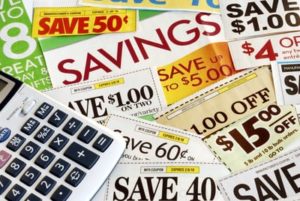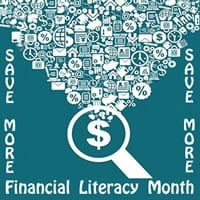 Do you feel like you are spending too much? Have you considered an all-cash month? Or how about a no spending month? Here are two great books to read to give you some ideas Not Buying It: My Year Without Shopping by Judith Levine or The Complete Tightwad Gazette by Amy Dacyczyn. #JillRussoFoster #FinancialLiteracyMonth
Do you feel like you are spending too much? Have you considered an all-cash month? Or how about a no spending month? Here are two great books to read to give you some ideas Not Buying It: My Year Without Shopping by Judith Levine or The Complete Tightwad Gazette by Amy Dacyczyn. #JillRussoFoster #FinancialLiteracyMonth
Financial Literacy Month #8
 While thinking about saving money, what can you eliminate from your life that would save you money? Can you bring your choice of beverage from home versus buying? Can you stop buying bottled beverages? Do you bring your lunch with you from home? We have eliminated the trash removal / recycle bill by taking it ourselves. We went from $75/month to $25/year. How can you save? #JillRussoFoster #FinancialLiteracyMonth
While thinking about saving money, what can you eliminate from your life that would save you money? Can you bring your choice of beverage from home versus buying? Can you stop buying bottled beverages? Do you bring your lunch with you from home? We have eliminated the trash removal / recycle bill by taking it ourselves. We went from $75/month to $25/year. How can you save? #JillRussoFoster #FinancialLiteracyMonth
Financial Literacy Month #7
 One way to save money is to repair items versus buying items again. If that’s not possible, maybe you can purchase the item at a discount or used. Buy Nothing is a really great group where people list what they want to get rid of and others offer to pick the item up for free. #JillRussoFoster #FinancialLiteracyMonth
One way to save money is to repair items versus buying items again. If that’s not possible, maybe you can purchase the item at a discount or used. Buy Nothing is a really great group where people list what they want to get rid of and others offer to pick the item up for free. #JillRussoFoster #FinancialLiteracyMonth
Back-to-School Supplies: A Zero Waste Guide
 This is from Zero Waste Schools:
This is from Zero Waste Schools:
Fall is an exciting and busy time as parents, teachers, and students
prepare for a new school year. Back-to-school is a great time to
gather school items that promote environmental sustainability and
save you money each year. Working together to incorporate zero
waste can be simple and fun too. Start your school year off right with
these zero waste back-to-school tips!
Reusing Supplies
Home
Shop at home first and reuse or refurbish items from previous years. Identify which school supplies are
still in good condition for reuse. Avoid purchasing new versions of these items until your child has
gotten full use from the ones they already own.
● Some commonly reused school supplies may include binders, backpacks, notebooks, scissors,
pencil pouches, and rulers.
● Used items can be easily refurbished through simple steps such as tearing out used paper in
notebooks, taping over small tears in folders or binders, or sewing work on backpacks or
clothing.
● Blogs and websites like Pinterest have many DIY craft ideas for refurbishing and decorating old
school supplies.
Friends, family, neighbors
Ask friends, family, or neighbors if they have any extra or lightly used school supplies and clothing that
they do not need. This will help your child acquire their necessary supplies while helping other families
clear out clutter. Consider scheduling an annual clothing or supplies swap where families bring items
that they do not plan on reusing. Finish the event by donating any unswapped items.
Thrift stores
Thrift stores can be a great source for new clothes, often selling name brands at a fraction of retail
prices. Many thrift stores also have an office supply section where lightly used school supplies can be
found. If in the Chicagoland area, visit The Waste Shed or the Creative Reuse Warehouse to shop for
used school supplies.
Buying New Supplies
Reduce non-recyclables
Less plastic: When you must purchase new products,
choose products that are durable and can be recycled once
they have been worn down, such as:
● Metal or wooden rulers
● Metal pencil sharpeners
● Metal safety scissors
● More durable folders
● Binders made with paper- or plant-based materials
● Spiral notebooks without plastic covers or folders
Bulk products: Purchase items in bulk to reduce the amount of packaging required for each item.
Buying in bulk is not only more environmentally sustainable, it can also save money.
Use durable, long-lasting products
Purchase durable products that you expect to last
several years, and handle these items with care.
Items that could be reused over multiple years
include backpacks, pencil pouches, rulers, pencil
sharpeners, scissors, paper clips, mechanical pencils,
locker accessories, and calculators. When initially
purchasing these products, consider buying classic
or simple designs that children are less likely to
outgrow.
Support eco-friendly production
Look for items that are produced in a sustainable way such as school supplies that are:
● Sourced from recycled material (look for the highest percentage of post-consumer recycled
content)
● Made with non-toxic and non-hazardous material such as PVC-free products
● Packaged in material that is recyclable or reusable
● Labeled with sustainability seals or certifications such as the Forest Stewardship Council seal
on paper and pencils
Most standard retailers will highlight their eco-friendly products on the product tag or their website.
Another option might be to purchase a pre-bundled sustainable school supply kits, which are offered
by some online retailers such as Green ABCs, Wisdom Supply, or Guided.
ZERO WASTE LUNCH SUPPLIES
Save money and make less garbage by packing a zero waste lunch from home. Instead of buying
disposable products that get used only once, pack a zero waste lunch with washable food and drink
containers, utensils, and cloth napkins. Buying food in bulk and portioning it into your own containers
also typically costs less than buying food in single-serve packaging. Visit www.wastefreelunches.org
to learn more.
WAYS FOR TEACHERS TO PROMOTE MORE SUSTAINABLE SUPPLIES
If you are a teacher, it can be easy and less expensive to promote
sustainability through your school supplies decisions.
Supplies list: Discuss with co-workers and administrators the idea
of creating a school supplies list that promotes reuse, durability, and
sustainability. A sustainable list might include items that are easy to
reuse or recycle, as well as a note on sustainability.
● Consider alternatives to plastic bags, such as paper envelopes.
● Consider paring down the school supply list and asking families to contribute money to a
classroom supplies fund. This fund can be used by the teacher to cover the cost of additional
supplies that the class may need on an as needed basis. This may also allow the teacher to
purchase some supplies, such as wipes and hand sanitizer, in larger sizes or in bulk, which cuts
down on packaging waste and may also be more cost effective.
● Recommend eco-friendly soaps and cleaners if parents are required to purchase those.
Classroom supplies: When gathering supplies for your own classroom, keep in mind the places you
might find used or recyclable supplies. Consider visiting organizations such as SCARCE, which allows
teachers and administrators to access donated school supplies. If in the Chicagoland area, visit The
Waste Shed or the Creative Reuse Warehouse to shop for used school supplies.
Make supplies communal to eliminate the need for labeling items. This also makes it easier to use
supplies from one year to the next. At the end of the school year, collect supplies, such as scissors and
rulers, to use again the following year. Be sure to remove these items from your supply list. The
classroom supplies fund mentioned above can be used to replace any items that may have gotten lost
during the school year.
For more information and to share your success stories, contact us at: ZeroWaste@SevenGenerationsAhead.org
The Holidays Are Here
The holidays are here. Yes, with many retailers starting there holiday shopping sales early this year, are you ready? This is a good thing, if you need to stay within a budget, start early.
First, make a list of all the people on your holiday gift list, then see if you can make changes.
Could you give a family gift instead of individual gifts?
Can you go in on a gift with someone else and share the cost?
Would a name draw work for the family party? With a name draw, each person buys only for the person whose name they drew. It’s fun and inexpensive. Do a separate drawing for the children so each child receives one gift and gives one gift. Make sure to set a dollar limit that everyone can afford.
Once your list is complete, set a firm amount for each person and don’t go over. The grand total of all your gifts should be a realistic amount that you can afford. Be honest with yourself and don’t overspend. You’ll regret it when the bills start coming in.
When shopping, keep your list of people and your budget amounts with you. Check the sales fliers now because holiday sales are already starting. Big retailers are also adding holiday layaway plans. Layaway plans work great if you know your budget. They allow you to make affordable payments without using a credit card.
You could also try giving gifts that don’t cost a lot of money. Service coupons are a wonderful gift. For example, you could cater a meal for a family that has a busy lifestyle. Try an inexpensive but meaningful gift, like a photo CD or memory album. The choices are endless if you take the time to think of what each person might enjoy most. This year with being at home more, I have come up with some great gift ideas that are meaningful, but not a budget breaker. I can’t tell you what they are as family members ready my newsletter.
The most important thing this holiday season is to have fun and enjoy your time together. Create new memories instead of new debts.
Simplifying Buying When Not Needed
How many times have you gone out and made a purchase only to come home to find out that you already had the item? This used to be us. 
Simplifying the kitchen is good thing makes what we need easier to locate when needed. Simplifying and organizing has been our mission. Now our kitchen cabinets and grouped together – one shelf for condiments, one for soups and other canned goods, one for pastas, etc. Kitchen cabinets a mess. Items put on any shelf and not grouped together.
Now it’s so much easier to see what is needed before going shopping and not may unnecessary purchases (all while saving money).
Simplifying One Times Use Items
Next, we are simplifying by getting iod of items the are one-time use items.
What items are in our kitchen that we only use for one purpose. These are taking up space and we can do without these. Think apple slicer, we can cut the apple with a knife. Th ink popsicle molds, how many times have I used them. I can only think of one time. We are working our way through the cabinets and drawers in our home. How many of these items do you have in your home?
ink popsicle molds, how many times have I used them. I can only think of one time. We are working our way through the cabinets and drawers in our home. How many of these items do you have in your home?
Items are piling up and will be ready to donate soon.
Simplification – Duplicates Be Gone
Simplifying the kitchen is good thing and makes what we need easier to locate when needed. 
During this stay at home time, we have begun getting rid of duplicates. Really, how many potato peelers can one kitchen need? Not to mention the hamburger flippers, ladles and more.
We have begun going through the process of cleaning out the kitchen cabinets and drawers. I can’t believe how much we have accumulated over the years. Maybe, its time to pretend we are moving and do a deep cleaning? Think about all the money we have wasted with buying these items! It’s time to think save money instead of buying another item.
Simplifying By Not Shopping
Being home with the Covid 19 requirements, caused me to spend more. Business was slower, minimal interaction and more time on my hands, cause me to spe nd more. Not a good thing.
nd more. Not a good thing.
Once I made this realization, I needed to take action. First, I had to understand that because something is a good buy, doesn’t mean I need it. This was a big step. Next, I eliminated apps on my phone and unsubscribed from emails from companies, reducing the temptation to spend.
Now before I buy something, I ask myself do I really need this? Is this something I would have bought without a sale? If the answer is “yes”, then I make the purchase.
Financial Literacy Month – Tip #20
Off Season
Here’s the tip from October 15 – More Income / Planning Ahead month:
Think off season. Companies that would be slow and looking for work may give you a better price than when they are busy and in high demand. Off season at this time of year would be patio furniture, barbeque grills, summer clothing, etc. Now might be the time to make the purchase and store it until the time when you can use it.
To purchase a copy of either of my books Thrive In Five: Take Charge of Your Finances in 5 Minutes a Day or 111 Ways To Save
#JillRussoFoster #30WaysToSave
- 1
- 2
- 3
- …
- 5
- Next Page »